The candle signs dictionary (What does it mean when my candle does that?)
Posted by Michelle Gruben on
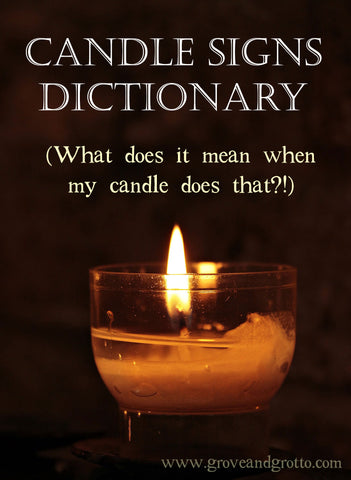
Candle magick is an incredibly popular and effective form of spellwork. But as any experienced witch will attest, spell candles sometimes seem to have a mind of their own. A dancing, fluttering flame seems to be communicating something…but what is it trying to say?
A bunch of traditions have sprung up around observing burning candles during a spell or ritual. Knowing these signs—and combining them with your own intuition—can give you important clues about the success or failure of your endeavor.
Interpreting candle signs is a broad folkloric practice that encompasses at least three types of divination: Pyromancy (divination by fire), ceromancy (divination by wax) and capromancy (divination by smoke).
I’ve listed as many candle signs and superstitions as I can, learned from my many witchy teachers and friends. Your tradition may have others. Keep in mind that signs and omens are very individual, and your methods of reading them will evolve over time.
A logical explanation
Anyone well-versed in candle-making can tell you what causes weird candle behavior in strictly non-magickal terms. A tall flame is caused by an untrimmed wick. Black soot is the result of oils or colorants being exposed to high heat. And a candle that suddenly goes out could be the sign of an unfriendly spirit…or just a stiff breeze.
We all know that physical properties of candles cause them to burn differently from each other. However, one of the most useful conceits in magickal work is that everything is a sign. Once you bring any mundane object into a magickal space, it becomes a tool for understanding. With that in mind, let's dispense for a while with the chemistry and physics of candle-burning, and get back to the magick.
Here are the interpretations for each possible candle-burning quirk:
Candle burns cleanly and evenly.
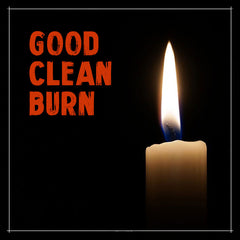
Generally, uneventful candle burnings are a good sign. When the candle burns without a lot of smoke, movement, noise, or dripping, your spellwork is going as planned. The results will manifest as expected. (Though not, perhaps, as quickly or dramatically as you might like.)
Tall, bright candle flame.
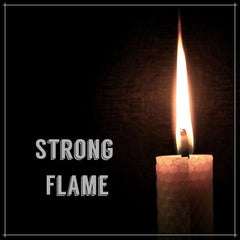
There is a lot of energy behind your spell. Barriers to your success are quickly falling away. A fast, happy result is likely.
Small, steady flame.
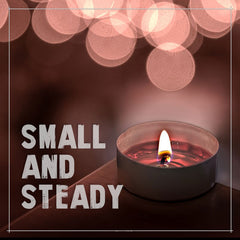
A low-burning flame indicates less energy is fueling the spell. A small but steadily burning flame is still a good sign—though it signals a need for patience and focus. A positive result is likely, though there may be a delay. Be persistent and keep your eye on the goal. If the candle flame increases in size during the working, it means the energy behind the spell is growing.
Small, weak candle flame.
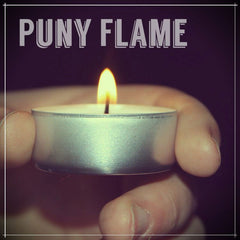
A small flame that flickers and bends is not a great sign in candle magick. The timing of the working could be wrong. Or you could be asking for an outcome that is unlikely or unfavorable in the long run. If the small flame falters or drowns in the melted wax, that is a sure sign that your petition will not be granted at this time.
Candle flame moves or dances.

An erratic, dancing flame signifies high energy in a spell—but also chaotic energy. A large dancing flame suggests success, but with potential complications. A small one means the spell may be overwhelmed by opposing forces. There may be other wills consciously or unconsciously working against you. Watch the flame closely to see if its shape or motion reveals anything to you.
Rapidly flickering candle flame.

Sometimes a candle flame will dim and brighten, dim and brighten, as if someone is flicking a light switch. In some folk magick traditions, a flickering candle flame is a certain indicator that spirits are present. If the candle is being used for devotional work (e.g. with gods, angels, or higher spirit guides), it means that the invocation was successful and your prayers are being acknowledged. A flickering candle flame is mildly trance-inducing, so you can use it as an opportunity to scry the fire for additional insights.
Candle pops or sputters.

A noisy candle indicates communication with (or interference by) outside forces. An uneven burn can signal that someone or something is working against you. Add more concentration and energy to the spell. (Or withdraw if you sense the resistance is too great.) Hisses, sputters, and whistles are sometimes said to carry messages from ancestors and spirits—try listening to them and hearing what they say.
The flame suddenly goes out.

The working is finished. A stronger opposing force has put an end to it. You should open the circle, ground yourself, and leave it be. Usually this means that your petition or spell—whatever it may be—will not manifest. However, in some cases, it can mean that the objective of the working has already been attained.
Candle will not extinguish.
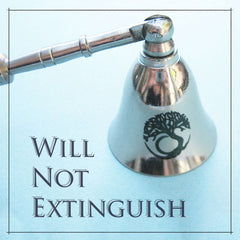
A candle flame that stubbornly stays lit means, “Sit down—you’re not done.” Perhaps you skipped a step or missed some important message during your candle magick ritual. Some helpful spirit or guide is nudging you to go back for what you forgot. When you feel that it has been settled, try extinguishing the candle again. Traditionally, spell candles are pinched or snuffed out—never blown.
Candle will not light at all.
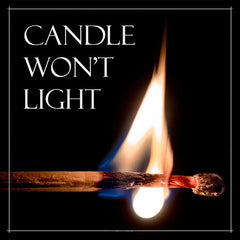
This spell cannot help you win the result you seek. The outcome may have already been decided, or be outside of your control. Take some time (days or weeks) to refocus your intention before trying again. (You can do a divination instead to find out more about what is blocking you.) Meditation and spiritual cleansing may be required before you can proceed with the spell.
Burning candle makes lots of smoke.

Abundant smoke is not a good or a bad sign. It indicates the element of Air is present in the spell, the element of communication and observation. When a spell candle puts out lots of smoke, you are being called upon to use your eyes and mind to read the situation. Look at the shape, color, timing, and movement of the smoke to gather helpful information about the working.
Candle makes a puff of white smoke.

White smoke is widely regarded to be a sign of blessings and benevolent spirits. If a candle breathes out a puff of white smoke, especially at a significant moment, it means that your wish will be granted.
Candle puts out clouds of black smoke.
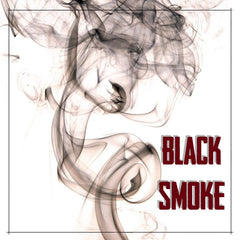
Dense, black smoke coming from a ritual candle is thought to represent negative energy. Conflict, bad luck, and opposing purposes surround your spellwork. Spend some time in prayer or meditation and do a cleansing ritual before proceeding with the working.
Candle smoke moves toward you.
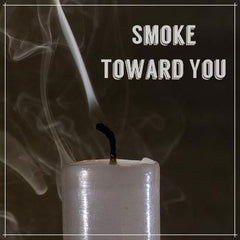
If the smoke from a ritual candle moves towards you, it portends success in attracting what you seek. For spells to draw love, money, or healing, this is a great sign. It means you will shortly achieve what you desire. The exception is for negative workings—curses, hexes, and tricks. If the candle smoke from a hexing candle moves toward you (or fills the room), it hints that you will not be able to escape responsibility for the effects of your magick.
Candle smoke moves away from you.
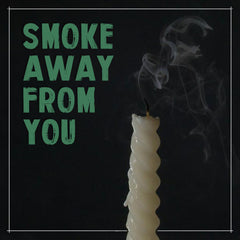
Smoke that moves dramatically away from you represents energies that are outward bound. In most spells, this is not a good omen. It means that something is escaping your grasp.
However, in spells to heal, influence, and manipulate others, the travelling smoke can mean that the working is going as planned. Pay attention to the speed, direction, and shape of the smoke to determine if your magick is on track.
Candle flame burns blue.
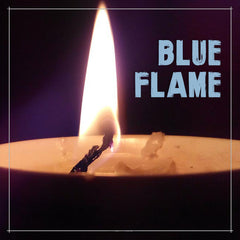
Blue fire is a sign of spiritual presence. It is the color of Angelic and Faery fire. If a spell candle burns blue or blue-white, it is a sign that high spiritual beings have taken an interest in your magick. Red or yellow flame means that more mundane—but still potentially powerful—energy is fueling the spell.
Burning candle forms a crater in the center, leaving wax on the sides.
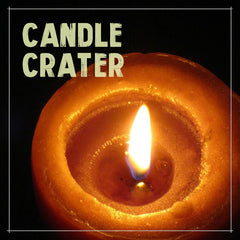
This is most common with large pillars and container candles, but it can also happen with votives and other candle shapes. The melted wax is centered closely around the wick, leaving tall walls of wax on the sides.
Nobody likes it when a candle burns incompletely, and it’s not a good sign in magick, either. It usually means that your will is too weak to cast an effective spell at this time. Or that the spell’s energies have been blocked from reaching their intended target.
Candle melts quickly into a puddle of wax.
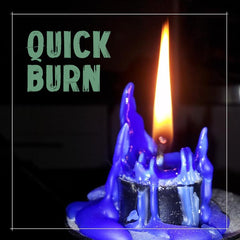
A candle that is not properly contained or leveled will often develop a hole in the side, causing melted wax to drip out quickly and shortening the life of the candle. “Spending” a candle quickly is not necessarily a bad sign—it can mean that there is passionate, accelerated energy behind your spell.
A pile of wax drippings is always an invitation to ceromancy (divination by wax). Examine the hardened wax with an open mind, seeing if any shapes or message emerge. There is a whole collection of folklore about what the various shapes mean…or you can just use your intuition.
Candle burns with no wax drips.

This is a sign of a well-conceived and properly executed spell. (It is also, I must say, the sign of a well-positioned and correctly-sized wick.) Your spell will go exactly as you have written and expressed it. The candle magick gods have no lessons for you today.
Wax drips on one side only.
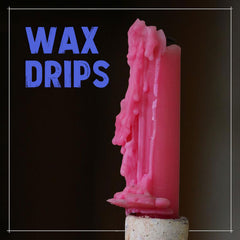
Something is out of balance. Expect an incomplete result. Some say that drips on the left (in relation to the magick worker) represent an emotional or psychic imbalance, while drips on the right mean your thoughts and beliefs are getting in the way of the spell.
Black pieces appear in melted wax.
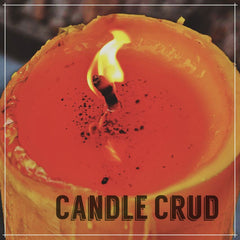
Sometimes, little bits of burnt wick will break off and sink in the melted wax. ("Candle crud" is the scientific term.) Debris in the wax signifies unintended consequences or work that will need to be done after the spell is complete. Guilt, broken hearts, karmic baggage, new hassles, and so on. Usually it's not super-serious—but not fun, either. Proceed with the working, but be ready to do some clean-up afterwards.
Soot collects on the candle container.
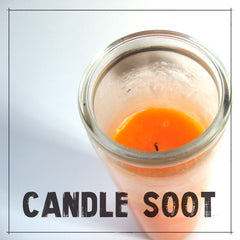
It is rare for a tall jar candle to burn without any soot appearing on the candle. Magick workers read the amount and location of the soot to gather information about the success or failure of the working.
Black soot is generally taken to be a sign of negative energy or interference within a spell working. If it appears only at the top of the jar, the opposition has most likely been overcome. If it covers the entire surface of the container, it means that the working has been thwarted and may need to be repeated.
White soot is a far rarer occurrence, and is said to represent spiritual communication and assistance.
A candle explodes, or a container breaks, or some other dramatic candle mishap.

A dramatic ending to your candle-burning ritual means the spellwork has been vetoed by a greater power. Cleanse yourself and your ritual space, and abandon the working until you have more information.
Want more magickal knowledge? Check out our other articles in the archive!
This original article is copyright 2018 by Michelle Gruben. Sharing and links back are welcome, but please don't copy and paste our content to other websites without permission.
